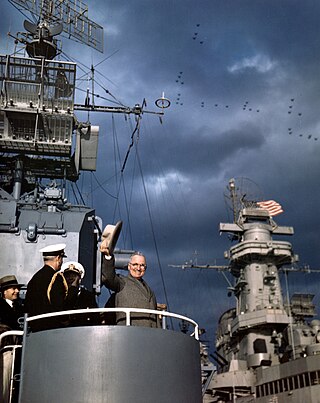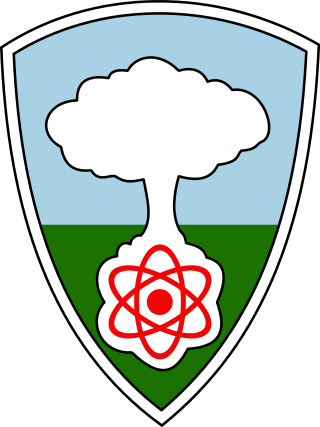The United States Armed Forces are the military forces of the United States. The armed forces consist of six service branches: the Army, Marine Corps, Navy, Air Force, Space Force, and Coast Guard. All six armed services are among the eight uniformed services of the United States, along with the U.S. Public Health Service Commissioned Corps and the NOAA Commissioned Officer Corps.

The National Security Act of 1947 was a law enacting major restructuring of the United States government's military and intelligence agencies following World War II. The majority of the provisions of the act took effect on September 18, 1947, the day after the Senate confirmed James Forrestal as the first secretary of defense.

The Portuguese Armed Forces are the military of Portugal. They include the General Staff of the Armed Forces, the other unified bodies and the three service branches: Portuguese Navy, Portuguese Army and Portuguese Air Force.

Louis Arthur Johnson was an American politician and attorney who served as the second United States Secretary of Defense from 1949 to 1950. He was the Assistant Secretary of War from 1937 to 1940 and the 15th national commander of the American Legion from 1932 to 1933.

The chairman of the Joint Chiefs of Staff (CJCS) is the presiding officer of the Joint Chiefs of Staff (JCS). The chairman is the highest-ranking and most senior military officer in the United States Armed Forces and the principal military advisor to the president, the National Security Council, the Homeland Security Council, and the secretary of defense. While the chairman of the Joint Chiefs of Staff outranks all other commissioned officers, the chairman is prohibited by law from having operational command authority over the armed forces; however, the chairman assists the president and the secretary of defense in exercising their command functions.

Arthur William Radford was an admiral and naval aviator of the United States Navy. In over 40 years of military service, Radford held a variety of positions including the vice chief of Naval Operations, commander of the United States Pacific Fleet and later the second chairman of the Joint Chiefs of Staff.

The "Revolt of the Admirals" was a policy and funding dispute within the United States government during the Cold War in 1949, involving a number of retired and active-duty United States Navy admirals. These included serving officers Admiral Louis E. Denfeld, Chief of Naval Operations, and Vice Admiral Gerald F. Bogan, as well as Fleet Admirals Chester Nimitz and William Halsey, senior officers during World War II.

Francis Patrick Matthews was an American who served as the 8th Supreme Knight of the Knights of Columbus from 1939 to 1945, the 50th United States Secretary of the Navy from 1949 to 1951, and United States Ambassador to Ireland from 1951 to 1952.

Interservice rivalry is rivalry between different branches of a country's armed forces. This may include competition between land, marine, naval, coastal, air, or space forces.

The United States Marine Corps is organized within the Department of the Navy, which is led by the Secretary of the Navy (SECNAV). The most senior Marine commissioned officer is the Commandant of the Marine Corps, responsible for organizing, recruiting, training, and equipping the Marine Corps so that it is ready for operation under the command of the unified combatant commanders. The Marine Corps is organized into four principal subdivisions: Headquarters Marine Corps, the Operating Forces, the Supporting Establishment, and the Marine Forces Reserve.

Naval Air Station Key West, is a naval air station and military airport located on Boca Chica Key, four miles (6 km) east of the central business district of Key West, Florida, United States.

The United States Army Aviation Branch is the aviation branch of the United States Army and the administrative organization that is responsible for doctrine, manning and configuration for all army aviation units. This branch was formerly considered to be one of the combat arms branches, but is today included within the "Maneuver, Fires and Effects" (MFE) classification, in accordance with current U.S. Army organizational doctrine.
The United States Air Force became a separate military service on 18 September 1947 with the implementation of the National Security Act of 1947. The Act created the National Military Establishment, later renamed the United States Department of Defense, which was composed of four of the five branches, the Army, Marine Corps, Navy, and a newly created Air Force. Prior to 1947, the responsibility for military aviation was divided between the Army for land-based operations and the Navy and Marine Corps for sea-based operations from aircraft carrier and amphibious aircraft. The Army created the first antecedent of the Air Force on 1 August 1907, which through a succession of changes of organization, titles, and missions advanced toward eventual separation 40 years later. The predecessor organizations leading up to today's U.S. Air Force are:
The structure of the United States Navy consists of four main bodies: the Office of the Secretary of the Navy, the Office of the Chief of Naval Operations, the operating forces, and the Shore Establishment.

The United States Marine Corps (USMC), also referred to as the United States Marines, is the maritime land force service branch of the United States Armed Forces responsible for conducting expeditionary and amphibious operations through combined arms, implementing its own infantry, artillery, aerial, and special operations forces. The U.S. Marine Corps is one of the eight uniformed services of the United States.
The Pace-Finletter MOU of 1952 was a memorandum of understanding (MOU) signed on 4 November 1952 between Secretary of the Air Force Thomas K. Finletter and Secretary of the Army Frank Pace that removed the weight restrictions on helicopters that the United States Army could use. It also widened the range of tasks the Army's helicopters could be used for. However, it also created an arbitrary 5,000 pound weight restriction limit on the Army's ability to fly fixed-wing aircraft. As a result, the U.S. Army today is dependent upon the United States Air Force to purchase and man fixed-wing ground-attack aircraft to fulfill close air support missions.
"...that established a fixed wing weight limit of five thousand pounds empty, but weight restrictions on helicopters were eliminated ..."

The Armed Forces Special Weapons Project (AFSWP) was a United States military agency responsible for those aspects of nuclear weapons remaining under military control after the Manhattan Project was succeeded by the Atomic Energy Commission on 1 January 1947. These responsibilities included the maintenance, storage, surveillance, security and handling of nuclear weapons, as well as supporting nuclear testing. The AFSWP was a joint organization, staffed by the United States Army, United States Navy and United States Air Force; its chief was supported by deputies from the other two services. Major General Leslie R. Groves, the former head of the Manhattan Project, was its first chief.

An air force in the broadest sense is the national military branch that primarily conducts aerial warfare. More specifically, it is the branch of a nation's armed services that is responsible for aerial warfare as distinct from an army aviation or naval aviation units. Typically, air forces are responsible for gaining control of the air, carrying out strategic and tactical bombing missions, and providing support to land and naval forces often in the form of aerial reconnaissance and close air support.

The Joint Airborne Troop Board was a multi-service US military board tasked with creating doctrine, tactics, techniques, and procedures for joint airborne operations and aerial logistical support operations. It was one of several boards that existed during the early years of the United States Department of Defense. The board existed from 1951 to 1956.


















